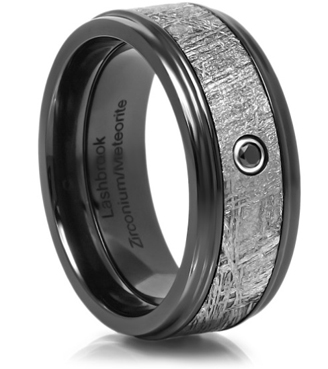
Men's wedding band with black diamond.
(Titanium-jewelry.com)
There's a lot of conflicting and confusing information on the Internet about black diamonds. It may be helpful to first introduce you to the types of black diamonds that exist. (Yes, contrary to popular belief, there is more than one kind of black diamond!)
Take a look:
The Five Types of Black Diamonds
1. Natural Crystalline Atomic Structure:
Contrary to popular opinion, naturally occurring black diamonds with orderly, lattice-like crystalline atomic structures (just like regular diamonds) do exist. They were formed like other natural diamonds deep beneath the Earth's surface by heat, pressure and time.
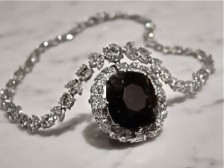
The Black Orlov Diamond was believed to be cursed at one time.
(Leibish.com)
These natural black diamonds are extremely rare - even more so than carbonados(see below). The opaque color of these rarities is caused by dark inclusions. These inclusions are actually other minerals trapped inside them, like graphite or hematite. These natural black diamonds can be cut with conventional diamond cutting tools. They have defined cleavage points like regular diamonds, although their numerous inclusions make it difficult to cut them. The Black Orlov is a famous 67.5 carat crystalline diamond believed to have been cursed at one time. It was last sold in 2005 to an undisclosed South African buyer for $360,000 dollars.
2. Natural Polycrystalline Atomic Structure (commonly called carbonados or carbonadoes):
Carbonado is a polycrystalline mineral consisting of carbon, graphite and diamond with an amorphous (shapeless) atomic structure. So carbonados have no defined cleavage points like normal diamonds do. Therefore, no two carbonados ever have identical internal features. Their internal fused" structure makes carbonados harder than other natural diamonds. They were not considered gem grade material until the 1990s. Prior to that time, they were only used for industrial purposes. Today, gem caliber carbonados are cut by proprietary laser processes. They can't be cut by conventional diamond cutting tools. These polycrystalline black diamonds have only been found in Brazil and Central Africa to date.
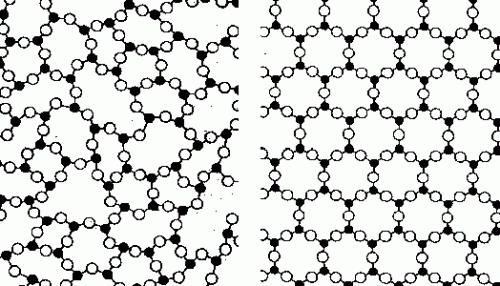
Polycrystalline (amorphous) atomic structure vs. Crystalline (lattice) atomic structure.
(Majordifferences.com)
Carbonados made news twice in recent history. First, the Swiss jeweler Fawaz Gruosi, claimed his stake to fame by specializing in black diamond jewelry. Through a brilliant marketing campaign beginning in 1996, he changed the world view of carbonado black diamonds. Their status changed from inferior industrial-use-only diamonds to ornamental sensations practically overnight.
The second time carbonados made a big splash with the media was in 2006. That's when geophysicist, Steven Haggerty, published his findings on carbonados (a term which he at first interchanged with the general term black diamonds"). Haggerty believes carbonados came from space billions of years ago during meteor impacts with the Earth.
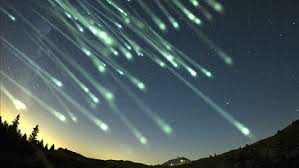
Geophysicist Steve Haggerty believes carbonados are from outer space.
(Wikispaces.com)
Unfortunately, by his use of the terms black diamond" and carbonado" interchangeably, Haggerty's initial interviews led many to believe that all naturally occurring black diamonds come from outer space. This is simply not true. In a 2012 article for Vice Media, he clarifies things:
There are distinctions among black diamonds. There are the so-called true black diamonds, which are diamonds in every sense of the word, except that they're black. These are largely but not exclusively from the Urals in the former Soviet Union, in Russia. The second type are carbonado, which are not known apart from two localities on Earth, namely Bahia in Brazil and the Central African Republic" - Stephen Haggerty
So, if you take away one thing from this article, remember that not all naturally occurring black diamonds are carbonados!
3. Lab created (Synthetic) Black Diamonds:
Lab-created black diamonds are identical to natural diamonds in crystalline (lattice-like) atomic structure. They have no inclusions or surface blemishes like natural black diamonds do. Synthetic black diamonds get their color from heat or radiation. Therefore, these lab grown gemstones are often more desirable than low-grade natural diamonds that have been color enhanced to make them appear black.
4. Color Enhanced Black Diamonds:
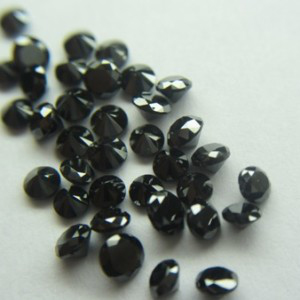
Color enhanced black diamonds.
(Gemone.com)
Most gem quality black diamonds available are color enhanced, low-grade (contain many inclusions) natural white or brown diamonds. Color enhanced diamonds are not truly black. They actually become a very deep green after exposure to extreme heat or radiation treatment. Radiation is the most common method of treating diamonds to make them appear black. (Don't worry! Modern processes to irradiate diamonds don't make them radioactive. They are perfectly safe for you to wear.) You can tell if a black diamond has been irradiated by looking at its girdle (midsection) under a microscope. You should be able to see the dark green color easily.
5. Black Diamond Simulants:
Simulant is fancy word for "fake", not the real deal. Colored glass, Cubic Zirconia, Moissonite, and most recently, Boron Carbide (a high-tech ceramic), are all simulants for black diamonds. Know what you are buying! If you want a genuine black diamond rather than a simulant, be sure to get proof of its composition in writing.
The 4 Cs Of Black Diamonds
The Four Cs of diamonds (clarity, color, cut and carat weight) are the rules by which jewelers and consumers judge diamond quality. Except for clarity, the 4Cs can also be used to judge the quality of gem quality of black diamonds:
1. Clarity:
Black diamond clarity (judgment of the internal flaws of a diamond) can't be determined because they are opaque (you can't see through them). Therefore, the GIA (Gemological Institute of America) issues a report called a Colored Diamond Identification and Origin Report (CDIOR) for black diamonds, rather than their standard report which includes clarity. The CDIOR identifies the black diamond's shape and cut, measurements, carat weight and origin.
Unlike the GIA, The EGL (European Gemological Laboratories) does grade black diamond clarity, with AAA being the best rating. The EGL clarity rating is based on external, not internal, conditions of the table and crown.
Consumers can judge the external clarity of black diamonds by observing them under a 10X jeweler's loupe. The diamond's surface should be smooth with no blemishes, dings or cracks.
2. Color:
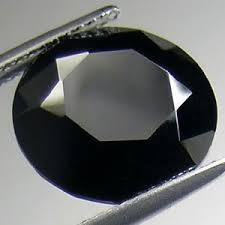
A fancy black diamond with exceptional color.
(Gemrockauctions.com)
Black diamonds are called fancy" diamonds, just like other colored diamonds are. Natural, crystalline and polycrystalline fancy black diamonds get their dark color from imbedded mineral inclusions. They can be light gray to deep black, depending on the type of inclusion. These natural black diamonds are rare and therefore command the highest prices in the market.
Most fancy black diamonds available today are low grade diamonds that have been irradiated to achieve their color. But regardless of the way in which the hue is derived, the most sought after black diamonds have a uniform, deep black color. They also have a smooth, polished surface that glistens in the light.
3. Shape:

Heart shape black diamond.
(Diamondzul.tripod.com)
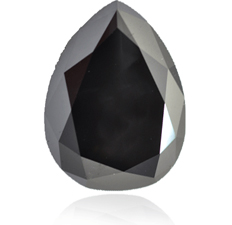
Pear shape black diamond.
(Gemonediamond.com)
Most black diamonds on the market are small, accent-sized diamonds. They have round shapes and simple cuts. Larger black diamonds can be purchased in several shapes and cuts. But natural fancy black diamonds contain so many inclusions that they are difficult to cut and shape without damaging them. So most complex shapes like hearts or pears are found in enhanced or lab-created black diamonds. They don't have the fracture issues that natural black diamonds do.
4. Carat Weight:
Most black diamonds on the market weigh under a carat. A one carat black diamond is slightly smaller than a one carat white diamond. This is because black diamonds are denser (heavier) than white diamonds. As with other diamonds, the larger the carat size of a natural black diamond, the more rare and expensive it is. Therefore, most large black diamonds in the market today are enhanced or lab-created.
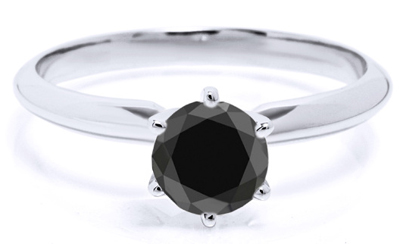
Gorgeous Black Diamond Solitaire.
(Yates & Co. Jewelers)
How Much Is My Black Diamond Worth?
Prices depend on size, origin and treatment. Natural black diamonds of any size can go for several thousand dollars. Color enhanced black diamonds can range between a hundred dollars to several hundred dollars, depending on size. Synthetic stones are also priced based on size. Simulants should always be disclosed and should always be much cheaper than the other alternatives.
I hope you enjoyed this article about black diamonds (and learned something too!) Be sure to check out our selection of black diamond jewelry.
References:
- Diamond Essentials. Printed in the United States: GIA, 2008.
- www.Gemsociety.org/article/black-diamonds
- www.ModernJeweler.com/black-diamonds
- www.Vice.com/rappers-love-black-diamonds
- www.Gemstoneslist.com/black-diamond
- www.gia.edu/gems-gemology
- www.gia.edu/boron-carbide-black-diamond
- www.YourEngagement101.com/what-you-need-to-know-buying-black-diamonds
- www.BeirutNightlife.com/king-of-black-diamonds
- www.InternetStones.com/black-orlov-diamond
Check out some black diamond rings and jewelry.





